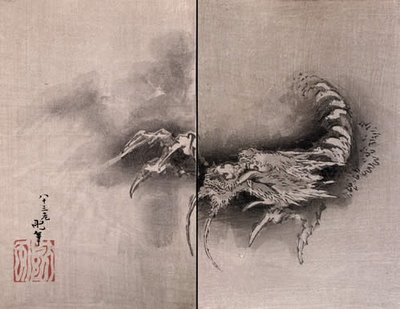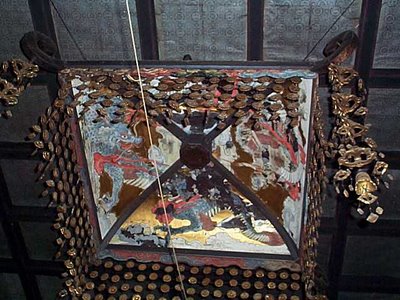:::::::::::::::::::::::::::::::::::::::::::::::::::::::::::::::::::::::::::::::::::::::::::::::::::::
Various Dragons from Hokusai 葛飾北斎

© 2000 The British Museum
Dragon ascending Mount Fuji
from 'One Hundred Views of Mount Fuji' (Fugaku hyakkei), a woodblock print
「富士越龍図」
Japan, Edo period, published AD 1835
Height: 227 mm, Width: 157 mm
Jack Hillier Collection
:::::::::::::::::::::::::::::::::::::::::::::::::::::::::::::::::::::::::::::::::::::::::::::::::::::

silk painting known as
'the dragon on smoke escaping from Mount Fuji'
:::::::::::::::::::::::::::::::::::::::::::::::::::::::::::::::::::::::::::::::::::::::::::::::::::::
© Pacificasiamuseum.org

Illustration of a Dragon from the Manga
Katsushika Hokusai (1760–1849)
1815
Leaf from a bound book, woodblock print, ink on paper
Pacific Asia Museum Collection
Gift of Evelyn and Eleanor Moles, 1982.27.7
:::::::::::::::::::::::::::::::::::::::::::::::::::::::::::::::::::::::::::::::::::::::::::::::::::::
Thundering Dragon at the Ceiling of Temple Shinpuku-Ji
真福寺・本堂. 横須賀市吉井

葛飾北斎の龍図
http://www.von.bne.jp/doragon/tenjyou/ryu-21/1.htm
More Thundering Ceiling Dragons
Thundering Dragons, Nari-ryuu LIST Japanese
:::::::::::::::::::::::::::::::::::::::::::::::::::::::::::::::::::::::::::::::::::::::::::::::::::::
「日月龍図」
Sun, Moon and a Dragon
Three hanging scrolls
と言う三幅の掛け軸みたいのがあって一枚は真っ赤な夕日、真ん中が墨絵の龍で右側に細い三日月の絵.
3点の掛け軸のセットになっていている。
:::::::::::::::::::::::::::::::::::::::::::::::::::::::::::::::::::::::::::::::::::::::::::::::::::::
In 1844 at age 85, Hokusai visited Obuse and spent about six months working on the Ryu (Dragon) and Ho-o (Chinese Phoenix) paintings for the Higashi-machi Festival float.
Read more about Hokusai and Daruma san
:::::::::::::::::::::::::::::::::::::::::::::::::::::::::::::::::::::::::::::::::::::::::::::::::::::
Hokusai Exhibition,
Arthur M. Sackler Gallery, March 2006
Hokusai, By Blake Gopnik
:::::::::::::::::::::::::::::::::::::::::::::::::::::::::::::::::::::::::::::::::::::::::::::::::::::
2012 - Year of the Dragon
初夢や辰の上に立つ富士の山
hatsu yume ya tatsu no ue ni tatsu Fuji no Yama
first dream -
a dragon at the foot
of Mount Fuji
This page inspired some Dragon haiku too.
Please have a look at them here.
Our Dragon Haiku Collection
:::::::::::::::::::::::::::::::::::::::::::::::::::::::::::::::::::::::::::::::::::::::::::::::::::::
Animal Manga by Hokusai

北斎漫画 動物百匹 葛飾北斎 HOKUSAI
.
北斎の名作版本が豆本で登場!
『北斎漫画』は、江戸時代の絵師・葛飾北斎が描いた代表的版本です。現代の漫画とは異なり、あらゆる図柄をアトランダムにまとめたもので、人物、動植物、風景、歴史、妖怪など、その図版は三千数百にも及ぶ百科事典です。
監修・解説 永田生慈
- source : shinise.ne.jp/unsodo/item -
:::::::::::::::::::::::::::::::::::::::::::::::::::::::::::::::::::::::::::::::::::::::::::::::::::::
. Hokusai and the Big Tsunami Wave .
[ . BACK to DARUMA MUSEUM TOP . ]
[ . BACK to WORLDKIGO . TOP . ]
:::::::::::::::::::::::::::::::::::::::::::::::::::::::::::::::::::::::::::::::::::::::::::::::::::::








7 comments:
Thanks for posting the Hokusai dragons.
I enjoy Hokusai's work, and I especially like the dragon ascending Fuji motif. I noticed you made reference to the Hokusai exhibit at the Sackler gallery in Washington during March, I have to work every weekend but I am going to try and get there.
in the ink,
dragons ascending Fuji,
lightning in winter
~K~
::::::::::::::::::::::::::::::::::::::::::::::::::::::::::::::::::::::
本当に江戸時代の画家のいイマジネイションはすごいと思います。
素敵な絵を有難う。
sakuo
Pacific Asia Museum
University of Southern California - USC
Daruma, Fudo, Dragon and more
.
Hokusai and the wave that swept the world
Jason Farago
In the beginning was the wave. The blue and white tsunami, ascending from the left of the composition like a massive claw, descends pitilessly on Mount Fuji – the most august mountain in Japan, turned in Katsushika Hokusai’s vision into a small and vulnerable hillock. Under the Wave off Kanagawa, one of Hokusai’s Thirty-Six Views of Mount Fuji, has been an icon of Japan since the print was first struck in 1830–31, yet it forms part of a complex global network of art, commerce, and politics. Its intense blue comes from Hokusai’s pioneering use of Prussian Blue ink – a foreign pigment, imported, probably via China, from England or Germany. The wave, from the beginning, stretched beyond Japan. Soon, it would crash over Europe.
This week the Museum of Fine Arts in Boston, home to the greatest collection of Japanese art outside Japan, opens a giant retrospective of the art of Hokusai, showcasing his indispensible woodblock prints of the genre we call ukiyo-e, or ‘images of the floating world’. It’s the second Hokusai retrospective in under a year; last autumn, the wait to see the artist’s two-part mega-show at the Grand Palais in Paris stretched to two hours or more. American and French audiences adore Hokusai – and have for centuries. He is, after all, not only one of the great figures of Japanese art, but a father figure of much of Western modernism. Without Hokusai, there might have been no Impressionism – and the global art world we today take for granted might look very different indeed.
continue
http://www.bbc.com/culture/story/20150409-the-wave-that-swept-the-world
.
Two Blind Men and Snowman
. Katsushika Hokusai 葛飾北斎 .
http://happyhaiku.blogspot.jp/2004/12/yukidaruma.html
Manpuku wagoojin 和合神 Wago-Jin - Deity of conjugal harmony
.
http://omamorifromjapan.blogspot.jp/2011/09/kesobumi-love-letter.html
[PMJS] Tracing "manga" back historically
.
Miriam Wattles wrote:
Crucially, I would argue that “manga” goes beyond the sequential narratives known as ストーリー漫画 (or “story manga”). The word manga has been and still is used for one-panel comics, which are not sequential in any ordinary sense. That Adam Kern (following Natsume Furunosuke) makes the argument that the “yellow-backed” illustrated fiction (kibyôshi) were a precursor of today’s manga depends on understanding manga to be “sequential art.” To me, only considering it as sequential and as a narrative diminishes the creative potential of manga. Manga in the late Meiji, Taisho, and early Showa came to include narratives (story manga) by the Taisho period, but it was so much more, comparable to the creative potential being realized in today’s graphica.
As Prof. Steiner points out in his essay, a number of terms overlapped and competed with manga in the Edo period: kyôga, giga, Toba-e, soga, rakuga, etc. I have worked extensively on Hanabusa Itchô, someone lauded from the Edo period through to Taisho for being the father of giga, and so spent some time excavating “giga” as a genre of the Edo period. (Discused in my book, The Life and Afterlives of Hanabusa Itchô, 2013, and in my essay “From Adverb to Noun: Some Thoughts on Hanabusa Itchô and the Instability of the ‘Giga’ Genre” in Ota Shôko, ed, Edo no shuppan bunka kara hajimatta imeeji kakumei,” 2007)
.
more
https://groups.google.com/forum/#!topic/pmjs/lVazjVo7_VM
.
Post a Comment